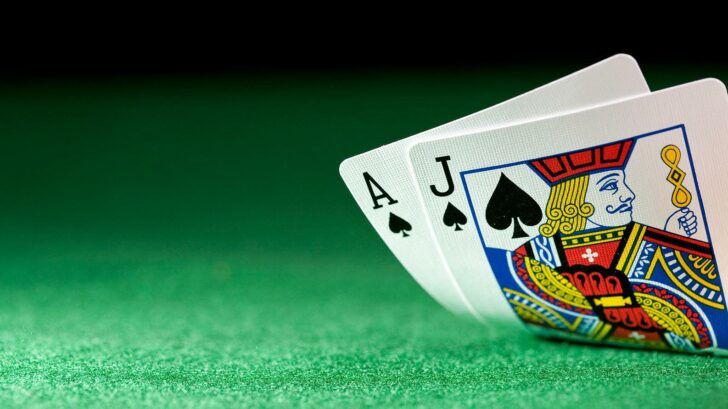Basic Blackjack Guide for Absolute Beginners

 Basic Blackjack
Basic BlackjackBlackjack’s simplicity shrouds a complex game of odds and options and we pull back the curtain by looking at the basics.
It can be quite intimidating to play blackjack for the first time. More experience players to either side of you have their system or blackjack counting strategy and you yourself have little or no idea what’s going on. This guide is going to solve that issue.
The most important aspect of the game is that winning at blackjack, whilst focused on acquiring cards of a value close or equal to (but not exceeding) 21, requires a player to beat the dealer’s hand not that of their fellow players. This is fundamental. Blackjack is a one-on-one game – it just looks like group activity.
It’s you against the dealer
Each player that places a bet will be dealt two cards. Usually these days those will be face up for all to see (which can make learning from example easier) and the dealer will also deal themselves two, one face up, one face down. Gambling your cards will be of greater value than the dealer’s is the essence of blackjack.
It is important to remember that whilst face cards are worth 10, Aces are worth either 1 or 11, and a combination of the two is pretty much a surefire winner. This doesn’t happen as often as you might wish. So with two cards totaling an amount substantially less than 21 you’re going to have to make a decision.
The two basic options are Hit or Stand, also sometimes known as draw or stay. Hit will get you another card to add to the two you already have, Stand will leave your hand as it is. Obviously if you’ve a number quite close to 21 you shouldn’t risk getting another card and if you’re nowhere near that total there’s no point standing on such a low number.
If you hit and the new card you receive pushes your total over 21 you’ve busted and will lose the amount you wagered on the hand. If you stand, there’s always the hope that the dealer will go bust and leave you the winner. What other players at the table are doing shouldn’t concern you for the time being.
More than just the basics
Whilst there are some blackjack rule variations that differ from casino to casino, some even playing an older “face-down” version of the game where players can only touch their cards with one hand, the basics are the same.
Unfortunately the basics just aren’t enough because there are other options as you eye your two cards and squint curiously at the dealer’s visible card. Whilst most of the time hit and stand are the only applicable choices, in some situations others can be called upon.
• Use free online blackjack to practice
• Learn the difference between the various odds on offer
• Smart strategies and stupid choices
The first is called splitting and this arises if you are dealt a pair. You can choose to split these two identical cards into two separate hands, although doing so will require you to duplicate the bet you made at the start. The game continues as before but now you’ve two hands to win with rather than just one.
Obviously the decision to split will depend on the value of the cards in the pair and also how likely it is those cards can make up a hand that could beat the dealer.
If the dealer has a face card, ten or ace showing it is possible they have blackjack (two cards totaling 21) and one can buy insurance to minimize possible loss against this hand. Whilst this might be used as part of smart strategies over the long term, we advise beginners to steer clear as it can accrue larger losses than necessary.
No Surrender
You can, if you look at the cards you were dealt and are totally unenthused, surrender. This will end your participation in that hand and recover you half the money you staked on the hand, the dealer taking the other half. This is the sensible choice of an experienced player that knows this hand will lead nowhere, beginners might be too inclined to do it too often.
Doubling down is another option but one best only indulged in when one is certain that the cards dealt to you are going to beat the dealer. This allows you to increase the amount you’ve staked on the hand by up to twice its value. The winnings could be bigger but so could the losses so doubling down is not for the faint of heart.
Of course sometimes there is no need for any of these options because you were naturally dealt an ace and a face card or ten. You have blackjack and the dealer will pay out 50% more to you because of it. In the earliest part of the history of blackjack it was only the ace of spades and a blackjack, these days it’s any ace and any face card.
Now of course every casino can have slightly different rules and it is ALWAYS best to check these before you begin playing. Casino staff are generally only too happy to help explain the idiosyncrasies of their establishment. The most notable difference between Blackjack tables in differing casinos are the odds being employed.
The odds on offer can vary
Typically the table will be offering odds of 3 to 2 (they pay out $3 for every $2 you wager) but sometimes the casino will only offer 6 to 5, which even a simple understanding of ratios will tell you, isn’t as good. The alternative is that the casino is offering 2 to 1, this is a better ratio and thus a better bet, but few casinos do this today.
The best way to learn blackjack is to play, and these days one need not enter a casino to do so with plenty of sites offering free online blackjack for novices. Obviously this is quite a different experience from being sat in a physical casino but the familiarity with the game might stand you in good stead later on. See you at the tables.




